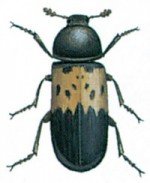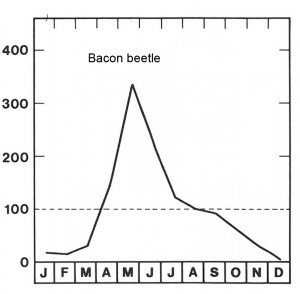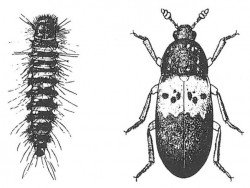

Latin: Dermestes lardarius. Also called the larder beetle.
Brownish black and easily recognisable on a bright fret with six dark spots across the front of the elytrons. The larvae are 15 mm long and the adult beetles measure 7-9 mm in length. The larvae are brown with a light underside and are clearly articulated with long bristles jutting out from all joints. At the rear, visible joint there are two dark crochets.
The bacon beetle was once a feared pest in any household. It lived in smoked hams, sausages, which was hanging from ceilings, and damaged dried fish. Today, with most meat stored in the refrigerator or freezer, the bacon beetle has no economic role in private homes. When bacon beetles are found in homes, they often come from leftovers that have been forgotten because of illness or travel, from dead mice under the floor, dead birds in the attic, in an exhaust ventilation duct, or perhaps from pigeons’ nests. Bacon beetles can also multiply rapidly in dry food for dogs and cats. Companies working with dried fish, hides or feed containing meat and bone meal, can get bacon beetle problems. The adult beetles are active and fly, and you can find them far from the place they developed. Females can lay several hundred eggs, preferably placed in cracks and crevices in food. The eggs hatch after 9 days at 17 ° C. At higher temperatures, e.g. 27 ° C, it only takes 3-4 days. The larvae are shady and quite mobile. They often leave their droppings as coherent elongated strands or “pearl chains”, which can be found in the contaminated food.

Under favourable conditions, the larvae mature in a month. At 18 -25 ° C they are typically 2 – 3 months to mature. The large larvae will usually leave whatever they lived in, and seek out a place where they can pupate. If they do not find a suitable natural cavity, they may instead chip away at wood, cardboard boxes and the like. That way they can make secondary damage in storages and during transport. It also explains why bacon beetles are often found in packaging and products where they would not normally live. The goods have simply been standing near the infested food, for example in a shipload.
In unheated locations bacon beetles overwinter as adult beetles, and are not seen until the next spring, when they become active again. Indoors, where there is heat in the winter, they are active year-round. Bacon beetle larvae destroy the goods in which they live. Bacon beetle larvae are unhealthy to eat. Therefore, dog or cat food with many bacon beetles must be discarded.




